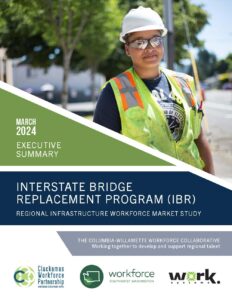 The Interstate 5 Bridge provides a critical connection between the states of Washington and Oregon that supports local jobs and families and is a vital trade route for regional, national and international economies.
The Interstate 5 Bridge provides a critical connection between the states of Washington and Oregon that supports local jobs and families and is a vital trade route for regional, national and international economies.
Worksystems and our partners Clackamas Workforce Partnership, Workforce SW Washington, Estolano Advisors, Oregon Employment Department, and Portland State University were commissioned by the Interstate Bridge Replacement Program (IBR) to conduct a Regional Infrastructure Workforce Market Study to analyze the strengths and opportunities that currently exist in the regional workforce. Click the links to read the Executive Summary and the full Report.
Some highlights from the study:
Introduction
- The results show the region’s workforce has shown strong growth in the last several years, but there are not enough workers who are women and people of color to meet the increasing demand for a more diverse workforce.
- The IBR program is just one of many public infrastructure projects in the Portland metro region taking place over the next decade that have set goals around utilizing a diverse workforce.
- The study includes many recommendations for the role that the IBR program can play in developing a stronger, more diverse workforce. The program is in discussions, both internally and with partner agencies, to identify which recommendations are within IBR’s purview to implement.
- The program will be intentional about which strategies to implement to maximize the effect it can have on improving diversity and inclusion among the regional workforce.
- The study was researched and produced in collaboration with Workforce SW Washington and Clackamas Workforce Partnership.
Findings
- In the Portland-Vancouver metro area, approximately 43,000 individuals are employed in nonresidential construction occupations as of 2022.
- Five percent are women
- 26 percent identify as workers of color
- Employment among workers of color is largely driven by those identifying as Hispanic/Latinx, while Black and Asian workers face underrepresentation in the trades.
- Women and individuals from diverse racial backgrounds are more likely to work in lower-paying trades, which highlights a challenge in achieving equitable representation and compensation within the construction industry.
- The study identifies large public capital projects requiring over 22,000 construction workers, with average goals suggesting a five-year demand for 3,800 apprentices, 4,700 people of color, and 2,500 female construction workers across 107 projects.
- While the overall workforce seems prepared to meet the demand, an occupational breakdown reveals shortages of:
- 270 people of color
- 1,050 women
- 1,290 apprentices in various trades
- 5,900 professional and technical employees (PTEs) are estimated to be needed, such as office clerks, project management specialists, and civil engineers.
Barriers
- Diverse worker retention is hindered by insufficient training and harassment issues.
- Opportunities for advancement are less accessible for women and people of color.
- Real-life challenges, including unstable work and childcare barriers, make it hard for some to achieve continuity in their careers.
- Construction shifts lack flexibility, and personal referrals are the dominant vehicle by which workers are connected to work.
- Public projects lacking clear workforce goals hamper the regional market’s adoption of diversity standards, which obstructs continuous opportunities for diverse workers.
Recommendations
The overarching themes of the study’s recommendations include:
- Enhancing regional construction workforce diversity through collaboration, coordination and targeted investments.
- Improving retention by addressing job site culture and challenges like childcare.
- Eliminating barriers for women and workers of color to foster a skilled workforce.
- Implementing effective project administration and procurement strategies.
- Boosting communication and education for project managers and contractors.
- Exploring and addressing equity opportunities in Professional, Technical and Engineering (PTE) fields.
IBR Program’s Next Steps
This study is one important step to inform efforts as the IBR program continues to develop specific workforce strategies. It provides a foundation to understand the current and anticipated future state of the workforce and opportunities to help promote equitable growth in the region’s economy.
IBR’s next steps in these efforts include:
- Analyzing recommendations to identify potential IBR program actions.
- Developing an action plan for implementation.
To learn more please contact Kelly Haines, Business Services Manager, khaines@worksystems,org.
This study was commissioned in May 2023 by the Oregon Department of Transportation and Washington State Department of Transportation for the Interstate I-5 Bridge Replacement program (IBR).

